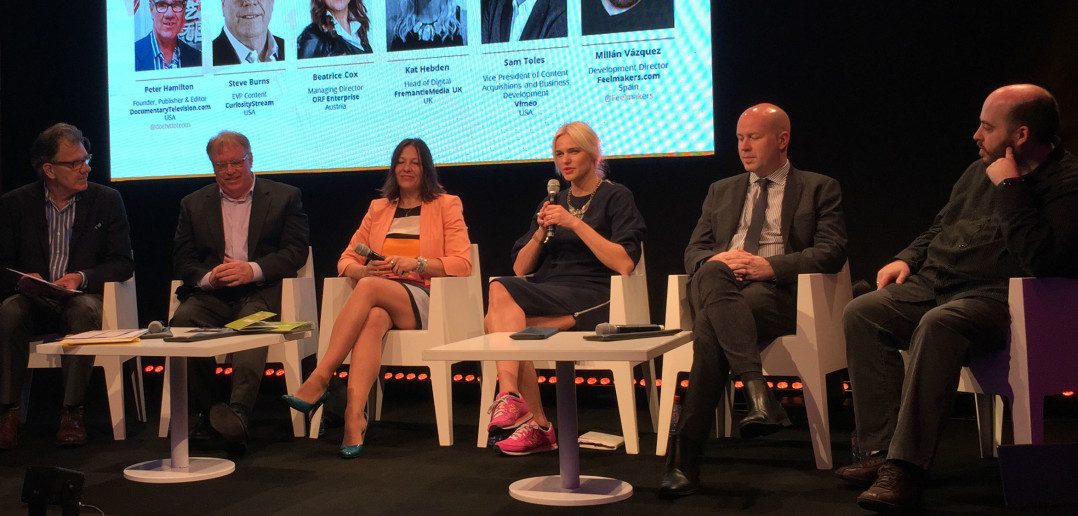Day two of the MIPDoc conference kicked off with a Producers Toolbox discussion of « bright ways to go global and digital with platforms », addressing some of the opportunities online for documentary producers, and how to make the most of them.
The panel comprised: Steve Burns EVP Content, CuriosityStream; Beatrice Cox, managing director, ORF Enterprise; Kat Hebden, head of digital, FremantleMedia UK; Sam Toles, VP of content acquisitions and business development, Vimeo; and Millán Vázquez, development director, Feelmakers.com. It was moderated by Peter Hamilton, founder, publisher and editor of DocumentaryTelevision.com.
Hebden opened with a showreel from FremantleMedia’s new Shotglass Media digital media label, which was announced last week. It spurred a question from Hamilton about whether new platforms are compatible with traditional documentaries, or whether they’re more suitable for factual entertainment.
« I definitely think that the new platforms can accommodate all types of programming, » said Burns. « We have science, technology, history, human spirit: things where you do not see them very frequently on television any more, but these are classic, high-quality programmes. » He noted that as reality shows « took over television » they squeezed out some of the shows that still have an audience. « We think we can satisfy that audience, » said Burns.
SVOD service CuriosityStream launched with 800 titles three weeks ago: a mixture of hour-long programmes from traditional producers and broadcasters, but also some content produced in-house – much of which is shortform. « Shortform can mean anything: we have pieces that are just as compelling at three minutes as others at six to eight minutes. Some are 15. »
Cox said that there’s a space for everything on ORF’s broadcast channels as well as Flimmit, the VOD platform that the broadcaster has invested in. « We really focus on television content, or television-produced content, but we also discover the world: we have a strand where we really focus on documentaries: blue-chip, one-hour, but also not blue-chip: we are focusing on small documentaries that big platforms like Netflix and Amazon would not look at, » she said.
The platform has 500 hours of documentaries in genres including science, wildlife, nature, religion and cookery. It launched a couple of months ago, focusing mainly on programmes acquired by ORF. Shortform isn’t currently on its agenda. « We keep the programmes as they are because we think they are good enough to be displayed like they are, » she said.
Hebden described the mix in FremantleMedia’s digital strategy: a mixture of spin-offs for its big TV shows and work for brands, as well as some original digital shows. « It’s using that expertise around a big show and shifting it into original programming, » she said. Hebden also talked about different motivations when making digital content for TV shows: for example it might be to bring younger people in to the main show, or to provide extra content for the show’s keenest existing viewers.
« A lot of what we do is marketing, I’ll be honest. We tease, we’re part of that machine that drives people to watch the show, » she said. But she described the experience of spin-offs as « almost running a separate show alongside the main show », while noting that the company will make four or five clips a week for a show like The Apprentice, and more like 10 for a show like X Factor.
« It’s all about understanding your audience, » she said. « People get very caught up with YouTube affecting TV ratings. It’s just another way to consume content… As content creators it’s still the same: if you create really good content, people will want to watch it. »
Over to Sam Toles from Vimeo, which has 170m viewers for its free online video service, but is building up its Vimeo On Demand paid store too. « If you are a online creator, not a large company but a general YouTube creator, if you get somebody to watch your content 50m times, you will basically end up with a cheque from YouTube for about $50,000, » he said. « Vimeo never went the ad-supported route: there’s no advertising in our platform. We decided to go the quality route. »
The on demand platform lets creators sell their work and keep 90% of the revenues. He suggested that someone selling a video on Vimeo for $5 only has to sell around 10,000 copies to match the revenues they’d get from 50m YouTube views. (Note, with the 90/10 split they’d actually need just over 11,000 sales on Vimeo).
Vimeo now has a 30-strong team acquiring and marketing content for its on-demand platform. « We continue to buy exclusive rights for content and first-window transactional, » he said, before stressing that filmmakers are free to set their own prices – even really high ones. « We have creators selling works on our platform for $1,000. We have creators selling work for $400, » said Toles, comparing this to Apple’s iTunes Store, where he claimed creators are shoehorned into specific price « buckets » – often $1.99 for shorter-form documentary work.
« We are very disruptive. One of my very good friends is my counterpart at Amazon: he has complimented me and cursed me! » he said, noting that just as Netflix has disrupted the broadcast world, « we feel the same way about transactional: it’s a space that’s more mature, has two dominant players at least in the US, and we have come in and said we want exclusivity and we will give you a better revenue share… to make Vimeo the most powerful player in the transactional industry. »
Vazquez talked next about Feelmakers.com, a recently-launched platform in Spain that is targeting a global audience with its mixture of documentaries, shorts and cartoons on demand. « From the very beginning we had it very clear in our minds that we had to achieve a wider audience, » he said. It runs a 50/50 revenue share model.
Toles was asked about what Vimeo does to promote the original content that it acquires. « One of the things that we look for is, I call it the core of a snowball. Without the core of a snowball, no matter how much I market, I cannot deadlift a product rom zero to 100 miles an hour, » he said. « We look for content that has some kind of a core audience: small, large, it depends. And then what we do is we amplify it… We have thresholds internally to say ‘this film has crossed $5,000 so we unlock a package of marketing to support it’… But we do really wanna see core audience, that’s the key metric we talk about. »
Hebden was asked what’s on FremantleMedia’s radar when it comes to off-YouTube content: is it looking at putting its content on direct rivals to Google’s video service, or thinking more about micro-content for apps like Vine, Instagram and Snapchat?
« It’s all of the above. We do a lot of content for brands, brand-supported, but what eventually we’d like is for audiences to pay for our content, » she said. « We’re looking at where our audiences are, and it’s social, particularly in sports. We’re looking at how a sports fan consumes content through the week, and looking at what platforms they want that served up on. The challenge is to monetise that, and it’s very challenging to monetise on social media. »
There are bright spots though: Hebden talked about a clip FremantleMedia posted on its Manchester United fans YouTube channel of an interview with an angry fan outside the stadium after the team had lost. It went viral on YouTube with three million views, but the money came from elsewhere.
« A kid in his bedroom in Leeds made an app, and it was just a soundboard from our content: we phoned him up and said ‘let’s do a deal, three ways between you, us and the talent, the guy in the video. And we made more money off that app in two months than we did in six months on YouTube in advertising revenues from those millions of views, » said Hebden.
« You could put your film on every platform: it’s not one or the other, » added Cox, as a final thought, noting that for documentary makers, the opportunity is to experiment with multiple platforms rather than putting all their eggs in one basket.
Check out MIPTV, MIP Digital Fronts, MIPDoc & MIPFormats 2015 full live coverage




